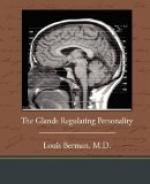STATURE AND GROWTH
Stature is essentially determined by the growth of the long bones. They are the pace-makers, and the muscles and soft tissues follow the pace they set. Now the primary determinant, catalyst or sensitizer of the growth of the long bones is the anterior pituitary. All statures should therefore be first scrutinized from the point of view of the pituitary. Individuals over six feet tall or under five feet five inches should be looked upon as having a pituitary trend. This pituitary trend may be primary, due to its own undergrowth or overgrowth, or it may be due to lack of inhibition from the sex glands such as occurs in eunuchs and eunuchoids, or excessive or premature inhibition from them as happens in certain salacious dwarfs.
The long bones grow at a point of junction between the bone proper and an overlying layer of gristle or cartilage, known as the zone of ossification. It is upon this zone of ossification that the various growth influences appear to focus and concentrate their efforts, among them the internal secretions. After growth has been finished, that is, after adolescence, these zones of ossification close, so that growth is no longer possible unless they become reactivated. Upon the zone of ossification must act the pituitary, and indirectly the thyroid, the interstitial cells, the thymus and the adrenals. Individuals oversized or undersized either belong to the pituitary type, or if hyphenated, have the pituitary as one of the dominants in their composition. The necessities of child-bearing determine a greater angle between trunk and lower extremities in the female. Underactivity of the pituitary, for instance, will prevent the development of the normal angle. The ratio in length of the upper limbs to the lower is a fairly constant relationship for each sex normally Deviations occur with a break somewhere in the chain of cooperation of the internal secretions controlling the growth of bone.




